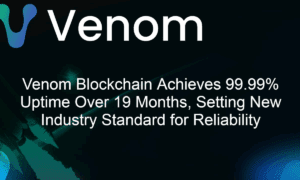“If you think Decentralized Finance (DeFi) is just another buzzword for cryptocurrency speculation, think again.”These are the words of Chirag Narang, Protocol Lead at Uniswap Foundation—an organization committed to fostering innovation in the DeFi ecosystem. While the term “DeFi” often conjures images of crypto whales making high-stakes trades, Narang believes this technology stands on the brink of changing everyday life for millions around the world.
Myth-Busting a Common Misconception
Since 2020, DeFi has exploded from under $1 billion in total value locked (TVL) to over $120 billion in 2024, according to aggregated industry data. Much of this growth has been reported in the context of cryptocurrency trading, yield farming, and the promise of quick gains. Yet, as Narang emphasizes, focusing solely on crypto speculation can obscure the real-world applications DeFi can deliver.
“DeFi goes far beyond token trading,” he says. “We’re seeing new financial tools emerge that are opening credit lines for the unbanked, cutting remittance fees, and even providing decentralized insurance for everyday risks.”
As someone deeply involved in developing Unichain—a purpose-built layer-2 blockchain under the Uniswap Foundation—Narang’s role is to ensure that DeFi’s transformative benefits reach wider audiences. “My goal is to ensure that DeFi builders have the tools, scalability, and secure environment they need to innovate freely,” Narang explains.
Why the Real World Needs DeFi
Current figures from the World Bank estimate that about 1.7 billion adults globally do not have access to a basic bank account. On top of that, the average remittance fee hovers around 7%, with some countries seeing costs well above 10%. Narang points out that DeFi solutions can offer direct, peer-to-peer systems, dramatically slashing these fees and granting financial access to those traditionally excluded from banks.
“One of the biggest myths is that DeFi only helps crypto traders,” he says. “Yet if you look at stablecoins used for remittances, or micro-lending protocols empowering small businesses, the impact is immediate and tangible.”
Below, we break down seven major areas where DeFi is already tackling real-world challenges.
1. Lending and Borrowing
Collateralized Loans
Platforms like Aave and Compound allow users to deposit crypto assets as collateral and borrow against them. This bypasses typical bank intermediaries and can provide faster access to liquidity, sometimes at lower interest rates.
“By collateralizing crypto assets, users can access funds without the usual paperwork or third-party gatekeepers,” Narang notes. “That’s a game-changer for anyone locked out of traditional lending.”
Undercollateralized Loans
A newer wave of DeFi protocols aims to offer undercollateralized lending, basing credit decisions on blockchain-based reputation systems rather than purely on pledged assets. This is poised to reach a broader audience—particularly small entrepreneurs in developing countries who lack a formal credit history.
“If we can crack the code on decentralized credit scoring, we can help people globally who’ve never qualified for a bank loan,” Narang adds.
Flash Loans
Flash loans, which must be repaid within a single blockchain transaction, open doors for rapid arbitrage and advanced trading strategies. While they might seem purely speculative, some see them as a powerful tool for quick liquidity in specialized scenarios.
2. Decentralized Exchanges (DEXs)
Automated Market Makers (AMMs)
DEXs such as Uniswap rely on AMMs rather than traditional order books. Liquidity pools replace centralized brokers, enabling peers to trade with minimal friction.
“AMMs break down barriers—anyone with an internet connection can become a liquidity provider and earn fees,” Narang explains.
Yield Farming
By contributing liquidity to AMMs, users can earn additional governance tokens or share in trading fees. Critics label this as speculative, but for many small-scale participants, yield farming offers a novel way to earn passive income in otherwise inaccessible markets.
3. Stablecoins and Payments
Cross-Border Payments
According to the World Bank, global remittances were nearly $800 billion in 2022. Traditional services can take days and charge hefty fees. In contrast, stablecoins—crypto assets pegged to a fiat currency—facilitate near-instant transactions at far lower cost.
“A stablecoin transfer might cost a fraction of a cent. For migrant workers sending money home, that difference matters,” Narang says.
Remittances
Because stablecoins don’t fluctuate wildly (unlike Bitcoin or Ether), they’re more practical for day-to-day use. Families can receive funds instantly, avoiding the long wait times and fees of traditional wire transfers.
Micropayments
Stablecoins enable fast, cheap payments for content and services that might otherwise be too small to justify. Think a few cents for per-article content access or donations, now feasible across borders without incurring outsized fees.
4. Asset Management
Decentralized Asset Management
DeFi protocols let users pool resources and invest in strategies—ranging from low-risk stablecoin yields to more advanced algorithmic trading—through automated smart contracts. Transparency is the key: everything is viewable on-chain.
Tokenized Assets
Real estate, stocks, and commodities can be digitized on the blockchain, creating liquidity in traditionally illiquid markets.
“Imagine selling a fraction of your property’s equity to global investors,” Narang muses. “That’s the power of tokenization.”
5. Prediction Markets
Platforms like Polymarket let users forecast outcomes of elections, sports events, or economic indicators. While similar to betting, these markets can offer a unique lens into global sentiment and real-time information aggregation.
“Decentralized prediction markets go beyond gambling,” Narang clarifies. “They’re a crowdsourced way to glean insights on world events—often more accurate than polls or pundits.”
6. Insurance
Decentralized Insurance
Smart contracts can disburse payouts automatically when certain conditions are met (e.g., stablecoin losing its peg, or a protocol suffering a hack). In agriculture, parametric insurance can be triggered by rainfall levels or temperature readings.
“Insurance is one of the most under-discussed elements of DeFi,” says Narang. “But it’s crucial for risk management—especially as more traditional companies look to adopt decentralized solutions.”
7. Identity and Access Management
Decentralized Identity
Projects like WorldID aim to create self-sovereign digital IDs. Instead of entrusting all personal data to centralized authorities, individuals retain control over their own credentials, proving only what’s necessary (age, residency, etc.) for each interaction.
“In many parts of the world, lacking an official ID can hold a person back from financial services,” Narang observes. “Decentralized identity could help break that cycle.”
Addressing the Skeptics
Even with these compelling applications, DeFi isn’t without challenges. Regulatory uncertainty, market volatility, and the risk of software exploits loom large. Narang believes regulatory clarity is evolving now with a crypto friendly administration, many jurisdictions are moving towards frameworks that support innovation while protecting consumers. Proactive dialogues with regulators in the U.S. signal a growing recognition of DeFi’s potential. Volatility is inherent in emerging markets, especially in crypto. However, DeFi is actively addressing this through the growth of stablecoins (e.g., USDC, USDT, DAI) and innovative financial products like algorithmic risk management and on-chain derivatives that provide hedging mechanisms. As liquidity deepens and institutional participation grows, volatility is expected to stabilize. Security remains a top priority in the industry, with significant advancements in smart contract auditing, formal verification, and insurance protocols. Leading platforms are now audited by multiple top-tier firms, and bug bounty programs are incentivizing ethical disclosures. Additionally, the rise of modular and upgradeable contracts is reducing vulnerabilities. While risks can’t be eliminated, the industry is rapidly evolving its security standards
Where Do We Go from Here?
As the DeFi ecosystem matures, Narang envisions a future where institutional players bring more capital and stability, and regulatory bodies enact frameworks that protect consumers while fostering innovation. The everyday uses of DeFi—like sending remittances, financing small businesses, or insuring a local community project—are rapidly expanding.
“We’re only scratching the surface,” Narang says. “I see a world where DeFi is as commonplace as online banking—except this time, individuals truly own their finances.”
If Narang and fellow innovators succeed, the next wave of DeFi could be defined not by speculative frenzy, but by pragmatic, life-changing tools. From collateral-free loans that empower the underbanked to tokenized securities that democratize investment, DeFi’s real-world applications may soon eclipse the hype surrounding the cryptocurrency market.
Conclusion
Far from being a mere playground for crypto traders, DeFi has already staked a claim in some of the most pressing needs of modern finance—from low-cost remittances to accessible lending. At the heart of these advancements are experts like Chirag Narang, whose work in the Uniswap Foundation and on Unichain is bridging the gap between blockchain technology and people’s daily financial lives.
“My hope is that, in a few years, we won’t even call it ‘DeFi’—it’ll just be finance,” Narang concludes.
For more on emerging trends and tangible impacts of Decentralized Finance, connect with Chirag Narang on LinkedIn.































